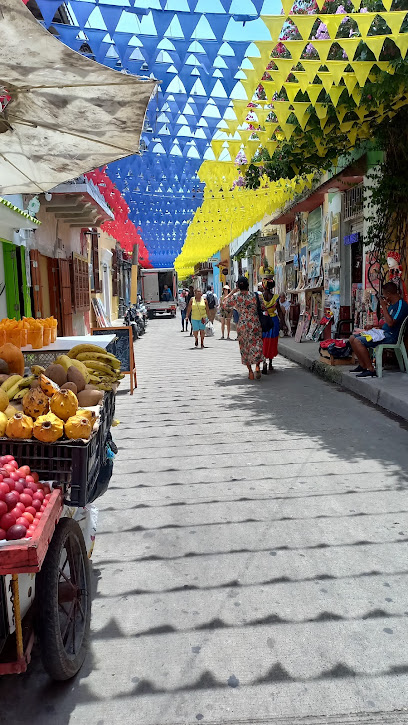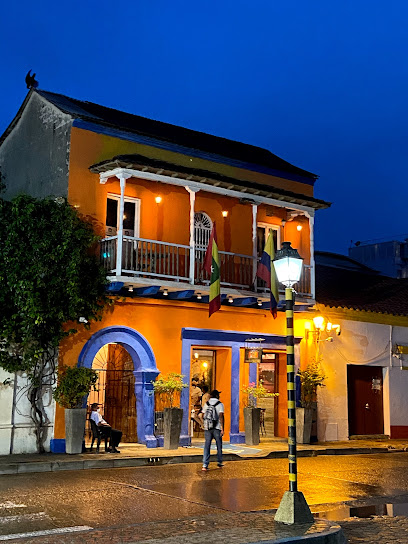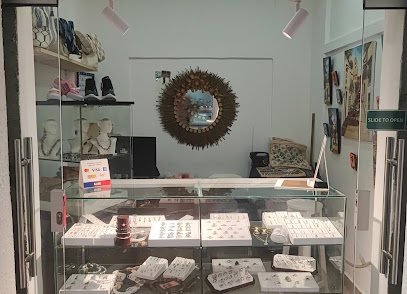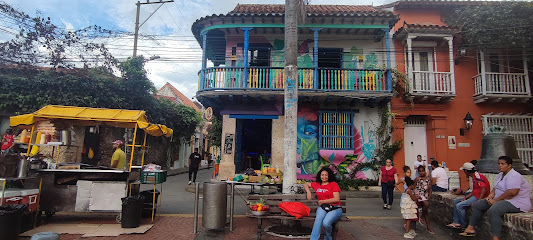
Getsemani: The Heartbeat of Cartagena's Culture
Discover Getsemani in Cartagena, Colombia: A vibrant neighborhood filled with history, culture, street art, and a lively atmosphere that captivates every visitor.
Getsemani, a vibrant neighborhood in Cartagena, Colombia, is a melting pot of history, culture, and modern-day charm. Once a working-class area, it has transformed into a lively hub that attracts tourists from all over the globe. As you wander through its colorful streets, you'll be greeted by stunning street art, colonial architecture, and the sounds of local music. Plaza de la Trinidad, the heart of Getsemani, is always buzzing with activity, offering a perfect spot to soak in the local atmosphere. The neighborhood is known for its bohemian vibe, with countless cafés, bars, and restaurants that serve an array of delicious food and drinks. From traditional Colombian dishes to international cuisine, there is something to satisfy every palate. The nightlife in Getsemani is equally captivating, with live music venues and dance clubs that keep the energy high well into the night. For history enthusiasts, Getsemani offers numerous points of interest, such as the San Roque Church and the historic walls that once protected the city. The community spirit is palpable, with friendly locals often engaging with visitors, sharing stories, and guiding them to hidden gems within the neighborhood. Whether you're looking to explore Cartagena's rich history, enjoy its culinary delights, or simply relax in a lively setting, Getsemani has something for everyone.
Local tips in Getsemani
- Visit Plaza de la Trinidad in the evening for a true local experience with street performers and food vendors.
- Don't miss the street art walking tours to fully appreciate the neighborhood's vibrant murals.
- Try the local arepas and fresh fruit juices from street vendors for an authentic taste of Colombia.
- Stay alert at night and stick to well-lit, populated areas to ensure safety.
- Wear comfortable walking shoes as the cobblestone streets can be uneven.
Getsemani: The Heartbeat of Cartagena's Culture
Getsemani, a vibrant neighborhood in Cartagena, Colombia, is a melting pot of history, culture, and modern-day charm. Once a working-class area, it has transformed into a lively hub that attracts tourists from all over the globe. As you wander through its colorful streets, you'll be greeted by stunning street art, colonial architecture, and the sounds of local music. Plaza de la Trinidad, the heart of Getsemani, is always buzzing with activity, offering a perfect spot to soak in the local atmosphere. The neighborhood is known for its bohemian vibe, with countless cafés, bars, and restaurants that serve an array of delicious food and drinks. From traditional Colombian dishes to international cuisine, there is something to satisfy every palate. The nightlife in Getsemani is equally captivating, with live music venues and dance clubs that keep the energy high well into the night. For history enthusiasts, Getsemani offers numerous points of interest, such as the San Roque Church and the historic walls that once protected the city. The community spirit is palpable, with friendly locals often engaging with visitors, sharing stories, and guiding them to hidden gems within the neighborhood. Whether you're looking to explore Cartagena's rich history, enjoy its culinary delights, or simply relax in a lively setting, Getsemani has something for everyone.
Iconic landmarks you can’t miss
Plaza de la Trinidad
Explore Plaza de la Trinidad, a vibrant cultural hub in Cartagena where history meets modern vibrancy, offering delightful food and unforgettable experiences.

Calle de Las Sombrillas
Explore Calle de Las Sombrillas in Cartagena: a vibrant street filled with colorful umbrellas, local art, and delicious Colombian cuisine.

Barrio Getsemaní Cartagena Bolívar
Explore Barrio Getsemaní, Cartagena's vibrant neighborhood filled with art, culture, and delicious Colombian cuisine.

Plazuela del Pozo
Explore the vibrant culture and history of Cartagena at Plazuela del Pozo, a must-visit museum and tourist attraction in the heart of Getsemani.

STREET OF THE HOLY SPIRIT
Experience the vibrant culture and rich history of Cartagena at the iconic Street of the Holy Spirit, where every corner tells a story.

Calle de La Sierpe
Discover the charm of Calle de La Sierpe, a historical landmark in Cartagena, filled with vibrant culture, art, and local flavors.

Getsemaní
Discover the vibrant heart of Getsemaní in Cartagena, where colorful streets, rich culture, and lively nightlife come together for an unforgettable experience.

Mural Pajaro
Explore Mural Pajaro: A Stunning Artistic Landmark in Cartagena's Vibrant Getsemani Neighborhood Capturing Local Culture and History.

El más hermoso callejon
Uncover the artistic beauty and vibrant culture of El Más Hermoso Callejón in Cartagena's Getsemaní neighborhood, a must-see for every traveler.

Street Art
Explore the captivating street art of Cartagena in Getsemaní, where vibrant murals and rich cultural stories come alive on every corner.

Unmissable attractions to see
Calle de Las Sombrillas
Explore the vibrant Calle de Las Sombrillas in Cartagena, a colorful street filled with artistic charm and local culture, perfect for unforgettable memories.

Camellón de los Mártires
Discover the beauty and history of Camellón de los Mártires, a stunning promenade in Cartagena, Colombia, perfect for leisurely strolls and rich cultural experiences.

Barrio Getsemaní Cartagena Bolívar
Discover the colorful streets and rich cultural heritage of Barrio Getsemaní, Cartagena's vibrant neighborhood filled with art, history, and lively local life.

Plazuela del Pozo
Explore the vibrant Plazuela del Pozo in Cartagena, a cultural hotspot filled with art, history, and lively local charm.

Getsemaní
Discover the vibrant streets of Getsemaní, Cartagena, where culture, history, and art collide in a colorful neighborhood experience.

Calle Tripita y Media
Discover the vibrant heart of Cartagena at Calle Tripita y Media, where culture, art, and local flavor come alive in a stunning atmosphere.

Mural Pajaro
Explore Mural Pajaro in Getsemani, Cartagena - a vibrant symbol of local art and culture that captures the spirit of Colombia.

Essential places to dine
Di Silvio Trattoria
Experience authentic Italian flavors at Di Silvio Trattoria in Cartagena's vibrant Getsemaní neighborhood.

Restaurante La Casa de Socorro
Experience authentic Caribbean cuisine at Restaurante La Casa de Socorro in vibrant Getsemaní, Cartagena - where flavor meets culture.

Restaurante-Bar San Nicolás
Savor exquisite local flavors at Restaurante-Bar San Nicolás in Getsemaní - where culinary tradition meets modern flair.

DOÑA LOLA comida del caribe
Experience authentic Caribbean cuisine at Doña Lola in Cartagena's lively Getsemani district, where flavors meet culture.

Stefanos bistro
Discover authentic Colombian flavors at Stefanos Bistro in Getsemani, where every dish tells a story.

LA RUMBA Lounge Bar
Discover LA RUMBA Lounge Bar: A fusion of authentic Italian flavors and vibrant nightlife in Getsemaní, Cartagena.

Casa del Tunel Restaurante Bar
Discover Casa del Tunel Restaurante Bar in Getsemaní for exquisite Colombian cuisine and innovative cocktails in a vibrant atmosphere.

A Los Chingadazos
Experience authentic Mexican cuisine at A Los Chingadazos in Cartagena's vibrant Getsemaní neighborhood.

Restaurante espiritu santo getsemani
Discover the flavors of Colombia at Restaurante Espiritu Santo in Getsemaní - where tradition meets vibrant culinary artistry.

Restaurant Mama-Nilma
Experience the best pizza in Cartagena's Getsemaní district at Restaurant Mama-Nilma – where local flavors meet culinary excellence.

Markets, malls and hidden boutiques
CHIQUI HOUSE BOUTIQUE
Discover unique Colombian craftsmanship at Chiqui House Boutique, the perfect shopping destination in Cartagena's vibrant Centro district.

St. Dom Cartagena
Explore St. Dom Cartagena, a boutique brimming with local craftsmanship and vibrant Colombian culture, located in the heart of Cartagena's historic district.

La Trinidad Plaza
Explore vibrant local crafts and unique souvenirs at La Trinidad Plaza in Getsemaní, Cartagena, a must-visit gift shop for every traveler.

Viral Store Cartagena
Discover trendy Colombian fashion at Viral Store Cartagena, located in the heart of vibrant Getsemani, perfect for stylish souvenirs and unique apparel.

Entremanos Artesanias Colombianas
Explore the colorful world of Colombian handicrafts at Entremanos Artesanias Colombianas in the heart of Cartagena's vibrant Centro district.

Shop
Explore Cartagena's vibrant gift shop in Getsemaní for unique souvenirs and handmade treasures that showcase Colombia's rich culture and artistry.

Lola
Explore women's fashion at Lola in Cartagena - where contemporary style meets local craftsmanship for the perfect shopping experience.

Jebo store
Explore the vibrant artistry of Jebo Store in Cartagena's Getsemani - a unique destination for exquisite handicrafts and costume jewelry.

Andrea Carta Boutique
Explore unique fashion and handcrafted accessories at Andrea Carta Boutique in Getsemani, Cartagena - a true reflection of Colombian artistry.

Tienda Getsemani
Discover local flavors and convenience at Tienda Getsemani in Cartagena's vibrant Getsemani district, your go-to store for essentials and regional delights.

Essential bars & hidden hideouts
Café Havana
Experience the lively atmosphere of Café Havana, a vibrant bar and Caribbean restaurant in Getsemaní, Cartagena, perfect for dancing and dining.

Restaurante-Bar San Nicolás
Discover the vibrant flavors of Cartagena at Restaurante-Bar San Nicolás, where traditional Colombian cuisine meets a lively bar atmosphere.

Beer Lovers Cartagena
Experience the best of Cartagena's craft beer scene at Beer Lovers Cartagena, a must-visit bar in vibrant Getsemaní.

Demente BAR TAPAS
Experience the vibrant flavors of Cartagena at Demente BAR TAPAS, where traditional Colombian dishes meet contemporary tapas in a lively setting.

Casa de la Cerveza
Experience the lively spirit of Cartagena at Casa de la Cerveza, where craft beers and local flavors unite in a vibrant atmosphere.

Tertulia de Getsemaní
Experience the heartbeat of Cartagena at Tertulia de Getsemaní—a lively salsa bar with cocktails, live music, and an unforgettable atmosphere.

Casa del Tunel Restaurante Bar
Discover the vibrant flavors of Cartagena at Casa del Tunel, a cozy gastropub blending local cuisine with a creative twist.

El Patio Getsemaní
Discover the rich flavors of Colombian cuisine at El Patio Getsemaní in Cartagena's vibrant Getsemaní neighborhood.

TSUNAMI CLUB CARTAGENA
Discover the electrifying atmosphere of Tsunami Club in Cartagena, where vibrant music, delicious cocktails, and unforgettable nights come together.

The Wolf Lair
Experience the vibrant nightlife of Cartagena at The Wolf Lair, a cocktail bar known for its creative drinks and inviting atmosphere.

Local Phrases
-
- HelloHola
[OH-lah] - GoodbyeAdiós
[ah-DYOS] - YesSí
[see] - NoNo
[noh] - Please/You're welcomePor favor/De nada
[por fah-VOR/deh NAH-dah] - Thank youGracias
[GRAH-syahs] - Excuse me/SorryPerdón
[pehr-DOHN] - How are you?¿Cómo estás?
[KOH-moh ehs-TAHS] - Fine. And you?Bien. ¿Y tú?
[byen. ee too] - Do you speak English?¿Hablas inglés?
[AH-blahs een-GLES] - I don't understandNo entiendo
[noh ehn-TYEHN-doh]
- HelloHola
-
- I'd like to see the menu, pleaseMe gustaría ver el menú, por favor
[meh goos-tah-REE-ah vehr ehl meh-NOO, por fah-VOR] - I don't eat meatNo como carne
[noh KOH-moh KAHR-neh] - Cheers!Salud!
[sah-LOOD] - I would like to pay, pleaseMe gustaría pagar, por favor
[meh goos-tah-REE-ah pah-GAHR, por fah-VOR]
- I'd like to see the menu, pleaseMe gustaría ver el menú, por favor
-
- Help!¡Ayuda!
[ah-YOO-dah] - Go away!¡Vete!
[VEH-teh] - Call the Police!¡Llama a la Policía!
[YAH-mah ah lah poh-lee-SEE-ah] - Call a doctor!¡Llama a un médico!
[YAH-mah ah oon MEH-dee-koh] - I'm lostEstoy perdido/a
[ehs-TOY pehr-DEE-doh/dah] - I'm illEstoy enfermo/a
[ehs-TOY ehn-FEHR-moh/dah]
- Help!¡Ayuda!
-
- I'd like to buy...Me gustaría comprar...
[meh goos-tah-REE-ah kohm-PRAR] - I'm just lookingSólo estoy mirando
[SOH-loh ehs-TOY mee-RAHN-doh] - How much is it?¿Cuánto cuesta?
[KWAHN-toh KWEHS-tah] - That's too expensiveEso es demasiado caro
[EH-soh es deh-mah-SYA-doh KAH-roh] - Can you lower the price?¿Puede rebajar el precio?
[PWEH-deh reh-bah-HAR ehl PREE-syoh]
- I'd like to buy...Me gustaría comprar...
-
- What time is it?¿Qué hora es?
[keh OH-rah ehs] - It's one o'clockEs la una
[ehs lah OO-nah] - Half past (10)Son las diez y media
[sohn lahs d'yehs ee MEH-dyah] - MorningMañana
[mah-NYAH-nah] - AfternoonTarde
[TAHR-deh] - EveningNoche
[NOH-cheh] - YesterdayAyer
[ah-YEHR] - TodayHoy
[oy] - TomorrowMañana
[mah-NYAH-nah] - 1Uno
[OO-noh] - 2Dos
[dohs] - 3Tres
[trehs] - 4Cuatro
[KWAH-troh] - 5Cinco
[SEEN-koh] - 6Seis
[says] - 7Siete
[syeh-teh] - 8Ocho
[OH-choh] - 9Nueve
[NWEH-veh] - 10Diez
[dyehs]
- What time is it?¿Qué hora es?
-
- Where's a/the...?¿Dónde está...?
[DOHN-deh ehs-TAH] - What's the address?¿Cuál es la dirección?
[KWAHL ehs lah dee-rehk-syohn] - Can you show me (on the map)?¿Puedes mostrarme (en el mapa)?
[PWEH-dehs mohs-TRAHR-meh (ehn ehl MAH-pah)] - When's the next (bus)?¿Cuándo es el próximo (autobús)?
[KWAHN-doh ehs ehl proh-KSEE-moh (ow-toh-BOOS)] - A ticket (to ....)Un boleto (a ....)
[oon boh-LEH-toh (ah ....)]
- Where's a/the...?¿Dónde está...?
History of Getsemani
-
Getsemani's history is deeply intertwined with the colonial era of Cartagena, which was founded in 1533 by Spanish explorer Pedro de Heredia. As the city grew, Getsemani emerged as a crucial settlement for slaves and laborers, providing essential services to the bustling port. Its proximity to the city center made it a strategic location for trade and commerce.
-
In the 16th century, Getsemani played a significant role in the defense of Cartagena against various invasions, notably by pirates and foreign powers. The construction of the San Felipe de Barajas Castle in the 16th century fortified the area, with Getsemani serving as a watchpoint for approaching threats. The coalescence of military architecture and local homes shaped the neighborhood's unique character.
-
Throughout the colonial period, Getsemani became a melting pot of cultures, featuring a blend of Indigenous, African, and Spanish influences. This fusion is reflected in the neighborhood's vibrant music, dance, and art, with traditions such as cumbia and vallenato originating from this cultural synthesis. The area's colorful street art today continues to tell the stories of its diverse heritage.
-
Getsemani was a focal point during Colombia's independence movement in the early 19th century. The neighborhood witnessed significant revolutionary activities, with many local residents participating in the struggle against Spanish rule. The nearby Plaza de la Trinidad became a gathering site for revolutionary discussions and planning, making Getsemani a historical landmark for Colombia's quest for freedom.
-
In recent decades, Getsemani has undergone a cultural renaissance, revitalizing its historical significance while grappling with gentrification. The influx of artists, musicians, and tourists has transformed the neighborhood into a vibrant hub of creativity. The local community actively works to preserve its cultural heritage amidst the rapid changes, showcasing the resilience of its identity.
Getsemani Essentials
-
Getsemani is conveniently located just a short walk from the historic walled city of Cartagena. From the airport, you can take a taxi or use ride-sharing services like Uber, which are widely available. If you are coming from other neighborhoods within Cartagena, walking is often the best way to reach Getsemani, as it allows you to enjoy the vibrant streets and local atmosphere. Alternatively, local buses and moto-taxis are available, but they may not be as direct or comfortable.
-
Getsemani is a compact neighborhood, making it ideal for exploration on foot. Many attractions, restaurants, and bars are within walking distance. If you prefer to cycle, you can rent bicycles from various shops in the area. While there are no trains or extensive public transport options within Getsemani, taxis and moto-taxis can be easily hailed for longer distances or if you’re tired from walking.
-
Getsemani is generally safe for tourists, but it's wise to stay cautious. Avoid walking alone at night, especially in poorly lit areas. The streets near the outskirts of Getsemani can be riskier, particularly around Calle 30 and Calle 25, known for petty crime. Always keep an eye on your belongings, and refrain from displaying valuables.
-
In case of emergency, dial 123 for police assistance or 125 for medical emergencies. There are local hospitals and clinics in Cartagena, with some located close to Getsemani. It is advisable to have travel insurance that covers medical emergencies. For minor health issues, pharmacies are available within the neighborhood.
-
Fashion: Do wear light, breathable clothing suitable for the tropical climate. Avoid overly casual or revealing attire in religious sites. Religion: Do respect local customs, especially when visiting churches. Public Transport: Do be polite and offer your seat to the elderly. Don’t engage in loud conversations or use your phone excessively on public transport. Greetings: Do greet people with a friendly 'Hola!' and a smile. Eating & Drinking: Do try local snacks from street vendors, but don’t drink tap water; opt for bottled water instead.
-
To experience Getsemani like a local, visit the Plaza de la Trinidad, where you can enjoy live music and street performances, especially in the evenings. Explore the vibrant street art that adorns many buildings and consider taking a guided tour to learn about the history and culture of the area. Try local dishes at small eateries and join in community events or festivals if your visit coincides with one. Don't forget to check out the local artisan markets for unique handicrafts.
Nearby Cities to Getsemani
-
Things To Do in Barranquilla
-
Things To Do in Sincelejo
-
Things To Do in Santa Marta
-
Things To Do in Riohacha
-
Things To Do in San Blas Islands
-
Things To Do in Cúcuta
-
Things To Do in Portobelo
-
Things To Do in Medellín
-
Things To Do in Panama City
-
Things To Do in Colon
-
Things To Do in Tunja
-
Things To Do in Manizales
-
Things To Do in Las Tablas
-
Things To Do in Chitre
-
Things To Do in Pereira







